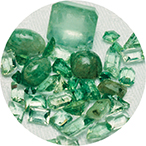22.2 Minerals
Reading Focus
Key Concepts
 What is a mineral?
What is a mineral? What are some important properties of minerals?
What are some important properties of minerals?
Vocabulary
rock
inorganic
streak
luster
hardness
fracture
cleavage
Reading Strategy
Outlining Before you read, make an outline of this section. Use the green headings as the main topics and the blue headings as subtopics. As you read, add supporting details.
Minerals |
|---|
|
Have you ever imagined finding a sunken treasure? In September 2002, a diver in Florida did just that. His job was to dive for objects from the Santa Margarita, a Spanish galleon, or treasure ship, that sank off the Florida Keys nearly 400 years ago. While rinsing sand off a conch shell found near the shipwreck, the diver spotted a shiny green stone. The stone proved to be a large and valuable emerald, like the ones in Figure 6.
Of course, the conch did not produce the emerald. The precious gem was almost certainly from the Santa Margarita. Scientists who have studied the emerald think that it originally came from mountains in South America where substances produced deep inside Earth have been brought toward the surface. Emeralds are a variety of the mineral beryl. The magnificent green color that makes emeralds so highly valued as gemstones is probably due to the presence of small amounts of chromium.
Figure 6 Emeralds are a form of the mineral beryl. These gems form deep beneath Earth's surface and are found in relatively few locations.





